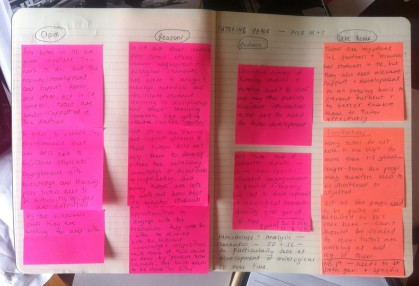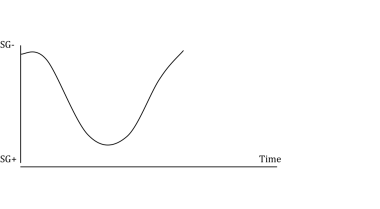I am currently supervising a PhD student, and she has been working on her literature review for the last few months, building the foundations and rationale for her study. Reading her successive drafts, and seeing her voice grow and develop, has given me pause for thought in terms of how we conceptualise, teach and write this thing called a literature review, especially in undergraduate education.
There has been a growing drive in the last five years or so, certainly in South Africa, towards making research a strong focus of undergraduate curricula, across the disciplinary map. In a higher education system that wants to grow its postgraduate student base, both in quantity and in quality, having prospective postgraduates learn how to design, manage and write about research projects while they are undergraduates is becoming increasingly valued and important. Thus, parts of research projects – in particular methodology courses and literature review assignments – are becoming more common at undergraduate level. In this post, I will focus in on literature reviews – specifically a few of the main shortcomings of how they tend to be taught and assessed at undergraduate level, and the implications for postgraduate research.
In a fairly traditional research assignment or project, the literature review is almost always the starting point. We read to map out the field, to work out who are researchers are that are working in this area and what they are (and are not yet) writing about. We read to work out what we think about the research we are interested in doing, to work out what kinds of research questions might be viable and also interesting to answer. We read to develop our own voices, and to build our credibility as we map our own research project onto the field, especially into gaps in the field we are working in. In short, we do a great deal of reading, and a great deal of thinking, scribbling, drafting and revising as we build – whether for a large or small project – the foundation and rationale for the research we plan on doing.
Once we have scoped all of this out, and have honed in on one question we can answer, we design a study, develop a theoretical framework, and proceed to generate relevant data that we can analyse and interpret in order to answer the research question. Doing all of that reviewing and reading of literature makes sense in the context of a research project as a whole, because what we do find will then speak back to that field – adding a voice and new ideas and thereby making a contribution. Without the research project as a whole (behind and) in front of the literature review, it can become a disconnected and therefore potentially unhelpful exercise, if its aim is to begin to acculturate undergraduate students into the hows and whys of doing their own research.
A literature review is less a review of existing literature – summary and compare ‘n contrast exercises – and more contextual framework for the research you propose to undertake. You are setting out, for your reader, the parts of the broader research field that are relevant to your own research – that they need to know about in order to understand why your research is necessary and important. Relevance is key. What you should not be doing is writing a long assignment showing the reader everything you have read, laboriously summarising, comparing, contrasting and synthesising the views of different authors. What tends to happen, in these kinds of review exercises, is that your research project and questions get lost in the tumult of other researchers’ projects and arguments. You lose your voice, and the relevance of all that reading is lost.
Unfortunately, most of the literature review assignment at undergraduate level I saw at the writing centre I used to manage over the last few years end up becoming exactly this kind of exercise, largely because there is no drive to understand the rationale for a research project students are invested in. Students are given a topic, perhaps a couple of the same readings with instructions to find two or three more related readings on their own, and then asked to summarise, synthesise and connect the readings in a literature review. In the better assignments, the topic will be a research question, but it is (as I have observed) difficult and puzzling for an undergraduate student to work out what they are reviewing in the literature and why, I believe because it is not their research, or because there is not project as a whole. The assignments thus do not end up helping these students learn how to do the kinds of literature review work that will be useful to them in postgraduate study.
This brings me to a second issue: postgraduate study, and the expectations of postgraduate students as compared to undergraduate students. Honours and Masters degrees are usually quite structured, and students embark on coursework before undertaking a manageable research project. The reading lists are shorter than they would be, in general, for a PhD study. But the task is, albeit on different levels, the same: you need to construct a research question, and develop a study that can be carried out in order to find an answer (crudely put). Thus, whatever existing research you read needs to be relevant to that project – it needs to help you understand your part of the field well; it needs to help you locate your proposed research in relation to existing research; it can help you work out appropriate theoretical and methodological frameworks or approaches; it defines and delimits your context and scope for the research; and it guides your reader into the rationale and need for your research. If all undergraduate students have learned is to summarise whole readings, without knowing how and what to select from them relevant to a specific project, how will they be able to accomplish the challenging task of building contextual and conceptual frameworks for their postgraduate research? If undergraduate literature review assignments are more often than not stand-alone assignments rather than initial parts of whole research projects, how will we need to adapt our supervision and mentoring practices at postgraduate level to bring students up to the levels of research and writing that are required of them?
Too often, postgraduate students who have done well as undergraduates end up feeling stupid and incompetent when they try to use what worked for them at undergraduate level in their postgraduate work, only to be told that they are not working at the right level, or in the right ways. Our work, in teaching undergraduate students the value and practice of research, is to look for clearer ways to align undergraduate and postgraduate expectations and study; to reimagine the teaching of research at undergraduate level so that it builds, cumulatively and in progressive stages, towards the capacity to continue learning and growing at postgraduate level. We cannot keep leaving it to the students themselves to work all of this out on their own, if indeed we want research, inquiry and curiosity to be much stronger and more visible in undergraduate and postgraduate curricula.






